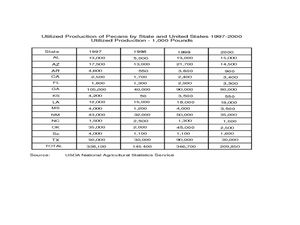Curated OER
How Is the Genetic Code Ultimately Translated Into a Protein?
Young scholars examine the functions of mRNA, rRNA and tRNA. They explain the steps in the protein synthesis process. They practice using new vocabulary as well.
Curated OER
Molecular Structure of Proteins
Students examine the effects different substances have on proteins. They test different molecules reaction to water. They discover how the amount of water affects the shape of the protein.
Curated OER
Enzymes
Students explore enzymes and what can inhibit and act as a catalyst for them. In this enzymes lesson students complete experiments on enzyme properties.
Curated OER
Construction of a Hemoglobin Gene
Learners see how eight pairs of triplets are equivalent to part of a gene and control a part of heredity. They comprehend how blood corpuscles manufacture normal hemoglobin. Students already comprehend that genes control the synthesis...
Curated OER
All Aboard for Protein Synthesis
Fourth graders walk through the process of transcription and translation to demonstrate and explain protein synthesis. They utilize a worksheet imbedded in this plan to guide their role play.
Curated OER
Nutrition and Fitness
Students explore nutrients found in foods. In this health lesson plan, students discuss the importance of a healthy diet and exercise. Students track the number of calories burned during various forms of exercise.
Curated OER
Secret Codes
Students examine Morse code and how it is used. In this secret codes lesson students decode messages, make their own codes and have other students crack the code.
Curated OER
Yeast - A Dihybrid Cross
Students make a yeast dihybrid cross and follow two forms of each of two traits: red growth versus cream color, and tryptophan-dependent versus tryptophan-independent.
Curated OER
Our Choices Matter: What You Eat
Young scholars will record their food choices for one week, noting calories, protein and vitamin content of foods using a given USDA website. Students will discuss whole class the important of proper nutrition and its role, and what...
Curated OER
Pseudogene Suite
Learners use Biology Workbench to explore DNA sequence data for the GULOP gene in humans, chimpanzees, orangutans, and crab-eating macaques and the beta globin gene and its pseduogene in humans, gorillas, and chimpanzees.
Curated OER
Amylase Enzyme In Saliva
Students test for amaylase enzyme in a variety of substances. Student pairs perform a series of tests to determine how long it takes the starch sample to change to sugar molecules and the blue color to disappear when various saliva...
Curated OER
The Structure And Functions of Proteins
Ninth graders investigate the structure of proteins and how it affects their function. They build a protein model with four helix units and describe how this structure aids the protein in doing its jobs.
Curated OER
The Conceptual Theory of Chromatography
Students conduct a lab to determine the best way to separate a variety of mixtures choosing between paper, thin layer and column chromatography. They use chromatography techniques to identify unknown substances and submit a lab report on...
Curated OER
Hopper Hunt: IPM Decision-making in Alfalfa
Students describe migrations and life cycle pattersn of a key alfalfa pest, the Porato Leafhopper. They define the Economic Inquiry Level and Economic Threshold. Students evaluate data in relation to profit as it applies to IPM. They...
Curated OER
Pecan Power
Students study the origins of pecans and complete a bar graph from the data they have discovered. In this pecan lesson plan, students draw pecans, discuss a pecan time line, and draw a bar graph comparing Arizona pecans to other states.
Curated OER
Lightning
Students study lightening and the history behind how it was used for electricity. For this electricity lesson students complete several experiments on the invention of the lightning rod.
Curated OER
Scientist Simulation
High schoolers imagine themselves working as research scientists completing the end-steps of a molecular research project and interpreting the data. They compare the gene sequences of normal and abnormal mice and evaluate the protein...
Curated OER
CONSTRUCTION OF A HEMOGLOBIN GENE
Students use research to see how eight pairs of triplets are equivalent to part of a gene and control a part of heredity. They also understand how red blood corpuscles manufacture normal hemoglobin.
Curated OER
Why Do We Need Vitamin C in Our Diet?
Students compare/contrast the DNA sequence data of the rat GULO gene to the inactive human GULO gene. They translate and align the sequences, and propose a scenario to explain the occurrence of an inactive DNA sequence to that of an...
Curated OER
Endocrine System
In this endocrine system worksheet, pupils match the correct gland found in the endocrine system to its hormone and target cell(s). They also describe the actions of each gland and hormone combined together.
Curated OER
Enzymes in Action: An Inquiry Approach to the Effects of Enzymes
Learners experiment with enzymes as key components of chemical reactions in all living things through this series of lessons.
Curated OER
Why do we need Vitamin C in our diet? Or Why do we carry old inactive genes in our genome?
Students explore and explain how mutations in the DNA sequence of a gene may be silent or result in phenotypic change in an organism and in its offspring. They analyze how evolution and biodiversity are the result of genetic changes that...
Curated OER
PICKING PEANUTS
Students create sentences, using words printed on pictures of peanuts. They are explained that the peanut is not really a nut, but a legume, related to beans and peas. Students are also told that the first peanuts grew in Brazil. They...
Curated OER
A TOUGH NUT TO CRACK
Based on a set of criteria, students will evaluate the quality of pecans.1. Bring a gram scale and papershell pecans. Provide five pecans for each student. 2. Divide the class into groups of five and provide each member with five pecans....
Other popular searches
- Proteins and Amino Acids
- Codon Amino Acids
- Proteins Amino Acids
- Amino Acid Chart
- Dna Proteins Amino Acids
- Amino Acid Sequences
- Protein Amino Acid
- Analogies for Amino Acid
- Barley and Amino Acids
- Co Don Amino Acids
- Amino Acid Lab
- Amino Acid Bingo

























